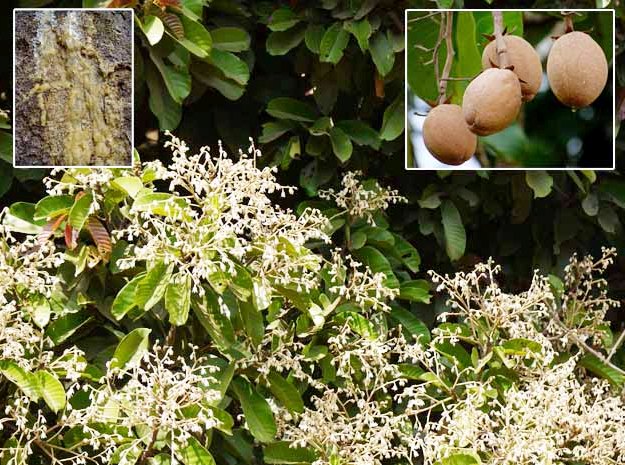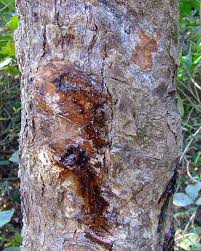Indian Copal Tree is a plant of immense economic importance. The timber of the tree is used in manufacturing of matches and plywood. The bark is used in Gur industry. The oil extracted from the seeds of the plant is used in manufacture of candles, soaps and cosmetics. The resin secreted from the tree trunk is used in varnishes, candles, ointments and incense. Resin is considered tonic, carminative and expectorant and is used against chronic bronchitis and throat troubles, piles, diarrhoea, rheumatism, infected wounds, earache and boils. However, today this valuable tree species is facing threat of extinction due to tree harvesting and habitat loss.
Economically Important Indian Copal Tree Faces Threat of Extinction
-Dr. Arvind Singh
Indian Copal Tree also is known as ‘White Damar’, ‘Piney Varnish’ and ‘Malabar Tallow’ is a tree species endemic to the Western Ghats of India. It is scientifically known as Vateria indica and belongs to the Dipterocarpaceae family of the flowering plants. In Hindi, the Indian Copal Tree is known as Kharuba and Badasal while in Sanskrit it is known as Ajkarna. Furthermore, in Malayalam, the plant is known as Baine, Kunturukkam and Paenoe, in Tamil as Painimaram and Dhupa maram and in Kannada as Bilagaggala, Damar and Dhupa mara.
Indian Copal Tree is a slow-growing large evergreen tree reaching a maximum height of about 60 m. The bark of the tree is smooth and grey in colour. Young branchlets are round and hairy and exude a resinous substance. The leaves of the tree are simple, petiolate and are spirally arranged. The fragrant white flowers are borne in branched clusters. The pale brown fruit is capsule type and contains a single seed.
Indian Copal Tree is found in South Indian states of Kerala, Karnataka and Tamil Nadu. It is a constituent tree species of the wet evergreen forest of the south-western Western Ghats which is extremely rich in biological diversity. This tree species is found from lowland forests to an elevation of up to 1200 m.
The flowering in the tree starts between January and March and the fruit ripen from May to July.
Indian Copal Tree is a plant of immense economic importance. The timber of the tree is used in the manufacturing of matches and plywood. The bark is used in Gur industry. The oil obtained from the seeds of the plant is used in the manufacture of candles, soaps and cosmetics. The resin secreted from the tree trunk is commercially known as white damar or dhupa is used in varnishes, candles, ointments and incense. The resin is extracted by scratching the tree bark.
The resin of the tree is medicinally important and is known as Sarja rasa in Ayurveda and Vellai Kungiliyam in Siddha. Thus the resin of the tree finds its use in the traditional system of disease treatments like Ayurveda and Siddha. Resin is considered a tonic, carminative and expectorant and is used in the treatment of chronic bronchitis and throat troubles, piles, diarrhoea, rheumatism, infected wounds, earache and boils. Kungiliya parpam is a Siddha preparation from the resin of Indian Copal Tree is effective in the treatment of urinary tract disorders. Resin also possesses anti-cancer properties. The bark of the tree is used in the treatment of malaria.
Over-exploitation and habitat loss are the two main threats to the Indian Copal Tree. The tree is harvested since colonial India for its timber. Habitat loss of the species is basically due to clearance of forests for agriculture and plantations.
Conservation of this economical tree species can be achieved through:
i. Checking the habitat loss
ii. Restoring the degraded habitats
iii. Putting a complete ban on the harvesting of live trees; and
iv. Motivating the local people for plantation of the tree species
Finally, it can be concluded that Indian Copal Tree is a plant of immense economic value which is facing threat of extinction due to tree harvesting and habitat loss. Therefore, it is the need of the hour to conserve this valuable tree species for the maintenance of biodiversity and environmental stability and to ensure the fulfilment of the need of the future generation.
-X-X-X-X-X-
 Dr. Arvind Singh is M. Sc. and Ph. D. in Botany with area of specialization in Ecology. He is a dedicated Researcher having more than four dozens of published research papers in the journals of national and international repute. His main area of research is Restoration of Mined Lands. However, he has also conducted research on the Vascular Flora of Banaras Hindu University Main Campus, Varanasi (India). Furthermore, he is also an active science writer having more than 10 dozens of published science articles in different periodicals of national repute. His email address is:
Dr. Arvind Singh is M. Sc. and Ph. D. in Botany with area of specialization in Ecology. He is a dedicated Researcher having more than four dozens of published research papers in the journals of national and international repute. His main area of research is Restoration of Mined Lands. However, he has also conducted research on the Vascular Flora of Banaras Hindu University Main Campus, Varanasi (India). Furthermore, he is also an active science writer having more than 10 dozens of published science articles in different periodicals of national repute. His email address is: 
